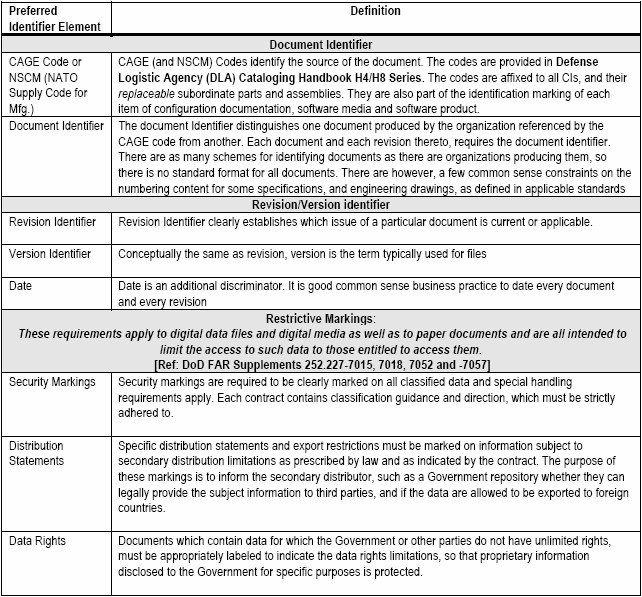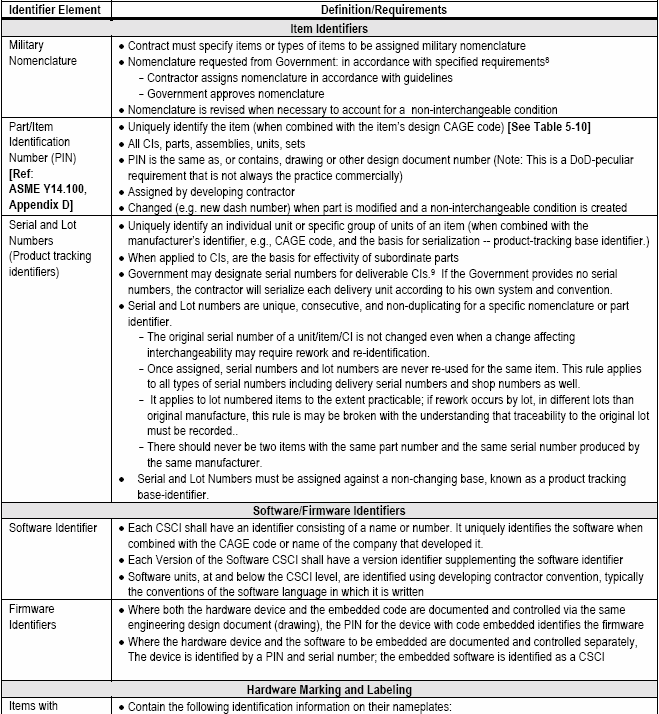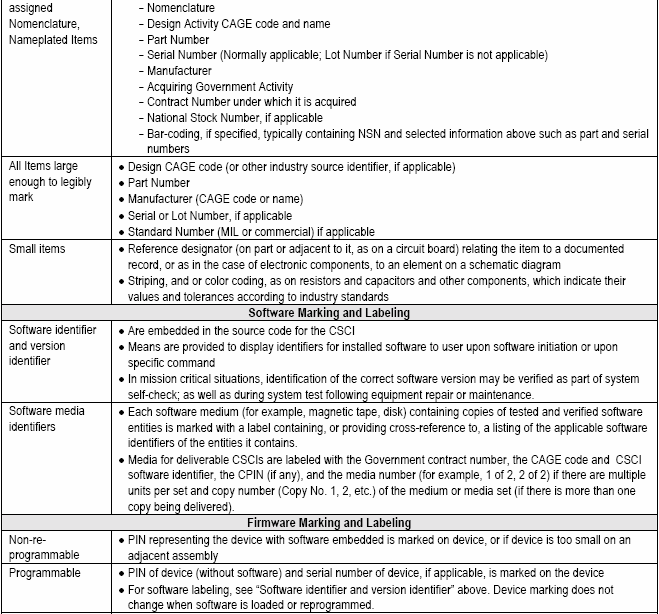MIL-HDBK-61A: Configuration Identification
< Previous | Contents | Next >
5.6 Document and Item Identification
This section describes the concepts for the assignment of identifiers to CIs, component parts and their associated configuration documentation. Clearly identified items and documentation are essential to effective configuration management throughout the life cycle, particularly during the deployment and operational support period when the marking on a part is the key to installing a correct replacement part and finding the proper installation, operation and maintenance instructions.
A document identification principle expressed in EIA/IS-649 is that each configuration document (as well as other documents) must have a unique identifier so that it can be associated correctly with the configuration of the item to which it relates. The DoD and all Military components use the following three elements to assure the unique identity of any document: CAGE code, document type and document identifier. In addition, revision identifier and/or date clearly specifies a specific issue of a document. [Detail: 5.6.4, Activity Guidelines: Table 5-10]
A document can have many representations, as for example a word processor file and a paper copy; a CAD file and a representation of that CAD file inserted in a document. In addition to the identification assigned to each document, the digital files for each version of each representation of the document, and its component files must be identified and managed. [Detail: Section 9, Data Management]
It is the responsibility of each individual assigned to manage an item of configuration documentation to employ the appropriate procedures of his organization which ensure:
-
The assignment of identifiers to the configuration documentation, including revision and version identifiers, when appropriate, and procedures to control the engineering release of new/revised data. [Refer to 5.6.2 and 5.7]
-
The application of applicable restrictive markings. [Detail: 5.6.2, Activity Guide: Table 5-10]
Table 5-10 provides document identification detail.
Activity Guide: Table 5-10. Document Identification

The following principles in EIA-649 apply to the Identification of Configuration Items; the terminology in parentheses are the common terms used in the defense, aerospace and electronics industries:
-
All products (Configuration Items) are assigned unique identifiers (e.g., Nomenclature, CAGE code, Part/Item Number) so that one product can be distinguished from other products; one configuration of a product can be distinguished from another; the source of a product can be determined; and the correct product information can be retrieved.
-
Individual units of a product are assigned a unique product unit identifier (Serial Number) when there is a need to distinguish one unit of the product from another unit of the product.
-
When a product is modified, it retains its original product unit identifier (Serial Number) even though its part identifying number is altered to reflect a new configuration.
-
A series of like units of a product is assigned a unique product group identifier (Lot Number or Date Code) when it is unnecessary or impracticable to identify individual units but nonetheless necessary to correlate units to a process, date, event, or test.
Contractors assign identifiers including serial and lot numbers to CIs and their component parts, as necessary to establish the CI effectivity of each configuration of each item of hardware and software. Items are marked or labeled with their applicable identifiers to enable correlation between the item, its configuration documentation, and other associated data, and to track maintenance and modification actions performed. Thus, serial and lot numbers are also known as tracking identifiers. For software, applicable identifiers are embedded in source and, when required, in object code and in alterable read-only memory devices (firmware).
a. Military Nomenclature and Nameplates.
The contract should specify requirements for the assignment of Government type designators and Nomenclature to CIs for which the Government needs to control, track and provide logistic support. Government Nomenclature is requested by a contractor and is included on CI nameplates. [Detail: 5.6.4 Activity Guide: Table 5-11]
b. Part/Item Identification Numbers (PIN)
The developing contractor assigns a discrete part/item identification number (PIN), generally referred to as a part number, to each CI and its subordinate parts and assemblies. The part number of a given part is changed whenever a non-interchangeable condition is created.
Part number format is at contractor option and a wide variety of formats are employed. The standard constraint within the defense industry had been a limitation to no more than 15 characters including dash numbers. However, with the increasing use of commercial items that are not so limited, many current systems accommodate 52 characters. Some contractors employ a mono-detail system in which one part is detailed on one drawing, and the drawing and the part number is the same. For practical reasons, some employ a multi-detailing system in which the drawing number may detail several parts and assemblies. Others use tabulated mono-detail drawings in which a drawing includes several iterations of a part. In the latter two cases, the drawing number is a base to which dash numbers are assigned for discrete parts controlled by that drawing.
The significant criteria are as expressed in the principles above: The part number must uniquely identify the specific part and unless otherwise specified, all CIs including parts, assemblies, units, sets and other pieces of military property are marked with their identifiers. [Detail: 5.6.4, Activity Guide: Table 5-11][Reference: ASME Y14.100, MIL-STD-129, and MIL-STD-150]
c. Software Identifiers
For each CSCI, the software identifier consists of a name or other identifier and a version identifier, assigned by the developing contractor. The identifiers relate the software to its associated configuration documentation (software requirements specification, software design documents, etc.), revision and release date. The software and version identifiers are embedded within the source code, and are marked on media containing the software. A method is typically employed to display the identifier and version to the user of the software upon command.
In a structured analysis and design approach to software development, the contractor assigns identifiers (which are usually mnemonic in form) to the software units below the CSCI level.
Firmware is labeled on the device or, if the device is too small, on the next higher assembly. [Details: 5.6.4, Activity Guide: Table 5-11]
d. Serial and Lot Numbers
CIs are the address for effectivity of subordinate parts, and for the effectivity of changes to subordinate parts. This means that the effectivity of a part is expressed in terms of the range of serial numbers of the CI end item into which it is assembled.
There are other ways of expressing the effectivity, particularly in commercial industry, but whether lot, block, FY contract, date or other term is used, it must translate as closely as possible to which serial numbered CIs will have the part installed.
There are also several kinds of related serial numbers that are employed in a CI production phase. The Government normally identifies the serial numbers to be affixed by the contractor on Government designated deliverable CIs. Government serial numbers are in a variety of formats depending upon the type of equipment and the policy of the acquisition command. The issuance of Government serial numbers should be avoided where the contractor has an acceptable process for assigning unique serial numbers. Among other impacts, it increases Government administrative expenses in maintaining serial number block assignment logs for numbers of items (and for multiple suppliers of those items) for the Government inventory.
Contractors assign serial numbers (sometimes referred to as shop numbers) to units in production. All engineering, manufacturing and quality data will refer to the shop numbers. These shop serial numbers may or may not correspond directly to the serial numbers to be marked on parts or nameplates (delivery numbers), because for various reasons the shop units may not complete the manufacturing process in sequence, or some units in the flow may be sent to another customer. (Example: Two out of every three units of a system are supplied to the US Army, but the third unit is supplied to a foreign Government under a foreign military sale (FMS) contract.)
Where impractical to serialize individual units, because of quantity or composition of the part or material, lot numbers are employed to identify a group of identical parts. Typically lot numbers are employed for subordinate parts below the CI level, but occasionally, they are appropriate at the CI level, as for example with rounds of ammunition. The lot numbers are controlled and are subject to the same constraints as the serial numbers.
The important factors, in evaluating a contractor's system of item identification is that:
-
There is an effective process for controlling the effectivity of parts by serial number (either shop number or delivery number)
-
A comprehensive cross-reference is maintained between the shop number of an item and its delivery serial number, or for lot-controlled items, between the manufacturing lot and the delivery lot. [Details: 5.6.4, Activity Guidelines: Table 5-11]
Table 5-11 provides details about item identification, including hardware, software and firmware.
Activity Guide: Table 5-11. Item Identification


The following are sources of nomenclature requirements: AFR 82-1, AR 70-50, MIL-STD-1464(AR), MIL-STD-1661(OS), MILSTD-1812, MIL-STD-196, MIL-STD-787, NAVMATINST 8800.4.
One method used on avionic equipment is to assign a series of three or four digit code letters/numbers to each fiscal year contract as a prefix for the sequential serial numbers assigned to each unit of the items to be delivered. Air vehicles normally have a block of serial numbers assigned for each contract.
For correct application of this information, see NOTE on Contents page